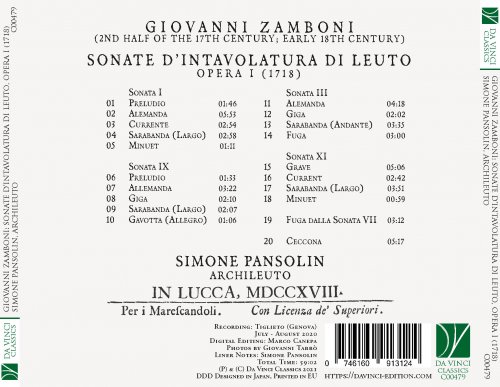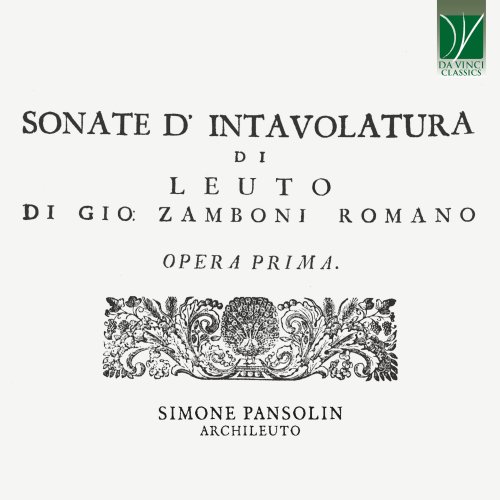
Simone Pansolin - Zamboni: sonate d'intavolutara di leuto di gio zamboni romano (Opera prima) (2021)
BAND/ARTIST: Simone Pansolin
- Title: Zamboni: sonate d'intavolutara di leuto di gio zamboni romano (Opera prima)
- Year Of Release: 2021
- Label: Da Vinci Classics
- Genre: Classical
- Quality: flac lossless (tracks)
- Total Time: 00:59:02
- Total Size: 289 mb
- WebSite: Album Preview
Tracklist
01. Sonata I, Op. 1: I. Preludio
02. Sonata I, Op. 1: II. Alemanda
03. Sonata I, Op. 1: III. Currente
04. Sonata I, Op. 1: IV. Sarabanda (Largo)
05. Sonata I, Op. 1: V. Minuet
06. Sonata IX, Op. 1: I. Preludio
07. Sonata IX, Op. 1: II. Allemanda
08. Sonata IX, Op. 1: III. Giga
09. Sonata IX, Op. 1: IV. Sarabanda (Largo)
10. Sonata IX, Op. 1: V. Gavotta (Allegro)
11. Sonata III, Op. 1: I. Alemanda
12. Sonata III, Op. 1: II. Giga
13. Sonata III, Op. 1: III. Sarabanda (Andante)
14. Sonata III, Op. 1: IV. Fuga
15. Sonata XI, Op. 1: I. Grave
16. Sonata XI, Op. 1: II. Current
17. Sonata XI, Op. 1: III. Sarabanda (Largo)
18. Sonata XI, Op. 1: IV. Minuet
19. Fuga dalla Sonata, vol. II, Op. 1
20. Ceccona, Op. 1

Little is known about the life of Giovanni Zamboni. Pisan chronicler Busoni defined him as “an excellent writer of musical counterpoint and a very virtuoso player of theorbo, lute, harpsichord, chitarra sminuita, mandola, mandolin, and also a skilled grinder of Eastern stones, i.e. jewels”. We find him as a “double-bassist” in the Primatial Church in Pisa from 1707 to 1713, i.e. in the years immediately preceding the publication of the works collected within this album. He also had the opportunity to work in the Cathedral Church of the same city. Besides these facts, very little certain information about him reached us; we do not even know his birth and death dates. The epithet “Roman” which is often juxtaposed to his name allows us to situate his activity within a rather precise context. His style, in fact, contains clear influences from the Roman music of his time, suggesting a very strong connection with the city of Rome, which was, at the time, a very important cultural and musical centre in the Italian peninsula. Regarding this, suffice it to cite Corelli’s work, and, as concerns the field of lute music proper, composers such as Johannes Hieronimus Kapsberger, Lelio Colista or Arcangelo Lori.
The eleven Sonate d’Intavolatura di Leuto, Opera Prima (Lucca, 1718) are, for all intents and purposes, the last printed publication for the lute in the form of tablature in Italy. Not only, in fact, the same composer failed to publish a second volume (or it was lost), but no Italian, after him, published further tablatures for this instrument. This style of notating music was abandoned in favour of a more modern writing style, based on the use of the pentagram. This does not mean that the lute (so most coeval musicians called the archlute, since it was the only kind of lute employed at the time) was forgotten in the period following the eleven Sonate. This instrument continued to be in use, although without great clamour; it was abundantly employed both for the continuo and for the performance of solo musical works.
This printed work, published by Marescandoli in Lucca and currently found, in a single specimen, at the Library of the Conservatorio Santa Cecilia in Rome, has an excellent technical quality. Still, it lacks dedication, preface or other indications for the performer as are usually found at the beginning of a publication. The composer’s skill in the manual activities suggests that he may have personally prepared the already-engraved printing plates. Under this viewpoint, Zamboni was very different from Kapsberger, who likely realized the plates for his Terzo and Quarto Libro d’intavolatura di Chitarone: their quality bears witness to his amateurish – if not inexistant – preparation as an engraver.
We know only two more manuscripts by Zamboni, containing 24 concertato madrigals in four parts, “con l’obbligo necessario del suo basso continuo”, published in Rome in 1755, and to which he owed the flattering epithet of “umilissimo e dignissimo virtuoso”. Just as the book of musical works for the archlute came late in the instrument’s history, similarly this publication is belated if related with the function of the madrigal in history. Along with the features of the “elaborata antica scuola”, these works also contain the “licenze cromatiche voltanti ed espressive” typical for the modern school. Still, the composer’s choice to use an obsolete musical genre at such a late time is curious.
01. Sonata I, Op. 1: I. Preludio
02. Sonata I, Op. 1: II. Alemanda
03. Sonata I, Op. 1: III. Currente
04. Sonata I, Op. 1: IV. Sarabanda (Largo)
05. Sonata I, Op. 1: V. Minuet
06. Sonata IX, Op. 1: I. Preludio
07. Sonata IX, Op. 1: II. Allemanda
08. Sonata IX, Op. 1: III. Giga
09. Sonata IX, Op. 1: IV. Sarabanda (Largo)
10. Sonata IX, Op. 1: V. Gavotta (Allegro)
11. Sonata III, Op. 1: I. Alemanda
12. Sonata III, Op. 1: II. Giga
13. Sonata III, Op. 1: III. Sarabanda (Andante)
14. Sonata III, Op. 1: IV. Fuga
15. Sonata XI, Op. 1: I. Grave
16. Sonata XI, Op. 1: II. Current
17. Sonata XI, Op. 1: III. Sarabanda (Largo)
18. Sonata XI, Op. 1: IV. Minuet
19. Fuga dalla Sonata, vol. II, Op. 1
20. Ceccona, Op. 1

Little is known about the life of Giovanni Zamboni. Pisan chronicler Busoni defined him as “an excellent writer of musical counterpoint and a very virtuoso player of theorbo, lute, harpsichord, chitarra sminuita, mandola, mandolin, and also a skilled grinder of Eastern stones, i.e. jewels”. We find him as a “double-bassist” in the Primatial Church in Pisa from 1707 to 1713, i.e. in the years immediately preceding the publication of the works collected within this album. He also had the opportunity to work in the Cathedral Church of the same city. Besides these facts, very little certain information about him reached us; we do not even know his birth and death dates. The epithet “Roman” which is often juxtaposed to his name allows us to situate his activity within a rather precise context. His style, in fact, contains clear influences from the Roman music of his time, suggesting a very strong connection with the city of Rome, which was, at the time, a very important cultural and musical centre in the Italian peninsula. Regarding this, suffice it to cite Corelli’s work, and, as concerns the field of lute music proper, composers such as Johannes Hieronimus Kapsberger, Lelio Colista or Arcangelo Lori.
The eleven Sonate d’Intavolatura di Leuto, Opera Prima (Lucca, 1718) are, for all intents and purposes, the last printed publication for the lute in the form of tablature in Italy. Not only, in fact, the same composer failed to publish a second volume (or it was lost), but no Italian, after him, published further tablatures for this instrument. This style of notating music was abandoned in favour of a more modern writing style, based on the use of the pentagram. This does not mean that the lute (so most coeval musicians called the archlute, since it was the only kind of lute employed at the time) was forgotten in the period following the eleven Sonate. This instrument continued to be in use, although without great clamour; it was abundantly employed both for the continuo and for the performance of solo musical works.
This printed work, published by Marescandoli in Lucca and currently found, in a single specimen, at the Library of the Conservatorio Santa Cecilia in Rome, has an excellent technical quality. Still, it lacks dedication, preface or other indications for the performer as are usually found at the beginning of a publication. The composer’s skill in the manual activities suggests that he may have personally prepared the already-engraved printing plates. Under this viewpoint, Zamboni was very different from Kapsberger, who likely realized the plates for his Terzo and Quarto Libro d’intavolatura di Chitarone: their quality bears witness to his amateurish – if not inexistant – preparation as an engraver.
We know only two more manuscripts by Zamboni, containing 24 concertato madrigals in four parts, “con l’obbligo necessario del suo basso continuo”, published in Rome in 1755, and to which he owed the flattering epithet of “umilissimo e dignissimo virtuoso”. Just as the book of musical works for the archlute came late in the instrument’s history, similarly this publication is belated if related with the function of the madrigal in history. Along with the features of the “elaborata antica scuola”, these works also contain the “licenze cromatiche voltanti ed espressive” typical for the modern school. Still, the composer’s choice to use an obsolete musical genre at such a late time is curious.
Year 2021 | Classical | FLAC / APE
As a ISRA.CLOUD's PREMIUM member you will have the following benefits:
- Unlimited high speed downloads
- Download directly without waiting time
- Unlimited parallel downloads
- Support for download accelerators
- No advertising
- Resume broken downloads


